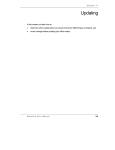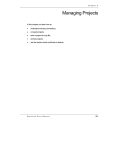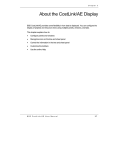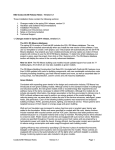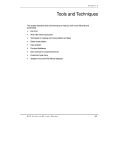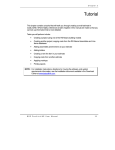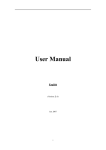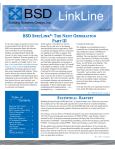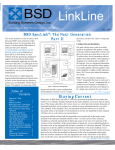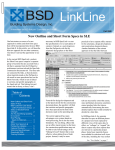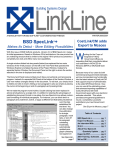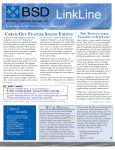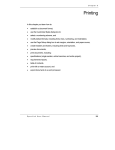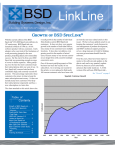Download LinkLine - Speclink
Transcript
LinkLine A Newsletter for BSD SoftLink ® Customers and Friends FALL 2005 Reference St andards on Demand Standards The latest release of BSD SpecLink® includes a valuable new feature. For the first time, virtually all reference standards in the master data include hyperlinks that provide immediate access to information about the standard and an opportunity to buy the document or, in some cases, view or download it at no cost. BSD SpecLink includes citations to thousands of reference standards – a total of 2,194 documents at last count. By referring to these industry standards instead of repeating relevant content within the specification sections themselves, we can keep the master specification text (and the edited project specifications) more concise. Only choices offered within the standard and deviations from the standard need to be included in the specification text. SpecLink has always incorporated some information about cited reference standards in the master notes attached to relevant paragraphs, particularly for standards that offer options. Over the years, BSD has frequently been asked by our users to make the actual reference standards available, in addition to the information included in the master notes. Technologically, that would be no problem for us. Unfortunately, it has proven to be a major business problem, because most of the See “Reference Standards” on page 7 Table of Contents Reference Standards On Demand ........................ LEED and Steel .................. LEED and Wood ................. BSD Customer Case Study: KOMW ................................ About Your SpecLink & PerSpective Updates ...... About the ASTM Updates .... New SpecLink Section List . Upcoming Events ............... Q&A ..................................... Training Schedule .............. 1 1 1 2 3 3 4 5 6 8 LEED™ and Steel LEED™ and Wood Getting the LEED credits for recycled materials may be easier than you think. If your project uses steel framing, either structural steel or light gage metal framing, or concrete framing with steel reinforcing, all that steel represents recycled material. All you have to do is document the quantity, cost, and source. But let’s step back a bit. What’s this about steel? Well, all steel manufactured in the U.S. is made of a significant amount of steel scrap. Over 12,000 auto dismantlers and 1,800 scrap dealers in North America reclaim steel for reuse! Forest Stewardship Council Certified wood is required for LEED-NC MR Credit 7. Although future editions of the LEED Rating System may allow certification by other organizations, at present the FSC certification is the only one accepted for LEED Certification. Achieving this credit requires that at least 50 percent of the woodbased materials in the project be FSCcertified. The computation of percentages must include all products made of solid wood, wood chip, or wood fiber, including furnishings and non-rented temporary construction such as formwork, bracing, and pedestrian barriers. BSD SpecLink® includes FSC-certification as an option in There are two basic manufacturing methods, the basic oxygen furnace (BOF) and the See “LEED and Steel” on page 5 See “LEED and Wood” on page 7 SpecLink Helps Krech, O’Brien y O’Brien,, Muller and Wass Significantl Significantly Reduce F orma tting Time Forma ormatting Krech, O’Brien, Muller and Wass (KOMW) is a unique collaboration of architects, structural engineers, interior designers and construction managers. Established in 1985, KOMW has built a strong organization recognized for thoughtful design, comprehensive professional service, good value and unquestionable ethics. The staff at KOMW knows that when individuals with a passion work as a team, great things can happen. They strive for responsible use of all ecological, human and financial resources as they collectively respond to programmatic issues, environmental forces and social conditions. The resultant goals include creating aesthetically pleasing, functional, more productive and healthier places for people to live and work. hope they didn’t forget to do this. Formatting – which should be a simple process - could take hours on previous projects. In 1996 they evaluated SpecLink. One look and they knew it would help them achieve the time savings they were looking for. The Solution: Vincent DiGiorno, Code and Specification Architect at KOMW, saw an immediate benefit from using SpecLink. He recalls, “Formatting the word processing files used to take 12-16 hours per project. With SpecLink it now takes 1-2 hours to format our specifications. I can set the formatting once and use it for almost all of our projects.” He remembers that with the word processing system he always had to be concerned with headers and footers, as well as the outline numbering. The page formatting and numbering are always right with SpecLink. The professionals at KOMW specialize in community and educational facilities, churches and faith-based buildings, multi- and high-end single family homes, clinics, offices and interiors, veterinary hospitals, production and industrial facilities, agricultural buildings and greenhouses. They have diverse experience with construction delivery from competitive bid to design-build, construction management and hybrid approaches. Through collaboration with professional consultants, they can provide for every requirement for new projects, adaptive reuse, alterations and additions. Their projects have construction budgets ranging from $1,000 to $25 million. The Need: Time is another valuable resource that the staff at KOMW wanted to use responsibly. They knew that their time was ultimately their client’s time. By utilizing an automated system, they were able to produce specifications faster than with a manual system. But the process they were using had some drawbacks. Any updates had to be copied from project to project. Not only did this take additional time, they also had to “We are regularly saving 25%-30% on all of our projects.” Vincent DiGiorno, Code and Specification Architect Krech, O’Brien, Muller and Wass Minneapolis Animal Care and Control Center DiGiorno was impressed with how easy SpecLink was to learn, “A normal project would take me about 40 hours. When I did my first project with SpecLink, I thought it would take additional time. However – even with a learning curve - I was able to complete it in the same amount of time. Our savings were immediate.” Now that he has become more proficient with SpecLink, he says, “We are regularly saving 25%-30% on all of our projects. The formatting we have set up for the various project types is always there.” Continued on next page 2 BSD LinkLine Fall 2005 About Your SpecLink & PerSpective Updates SpecLink+ St atistics: Sta • • • • • • 646 sections total, 343 updated or new (53%) 8 new non-proprietary sections 514 non-proprietary sections, 278 updated or new (54%) 132 proprietary sections, 65 updated (49%) 22 sections with built-in checklists 103,327 paragraphs 111,367 internal links (targets and consequences) 24,174 notes to specifier 10,150 notes with live hyperlinks to Internet web pages 2,119 external documents referenced, 48% verified, with live hyperlinks to order information • • • • • • • • • 949 ASTMs referenced, 31% revised 4 obsolete ASTMs removed 185 standards organizations referenced 1 new standards organization 2,297 manufacturer listings, with live hyperlinks to their webs sites 920 unique manufacturers listed in 355 non-proprietary sections • • • • • PerSpective Performance Specs St atistics: Sta • • • Short F orm Specs St atistics: Form Sta • 16 sections corresponding to MasterFormat 1995 divisions 11 sections updated (87%) 8,301 paragraphs 819 notes to specifier 8,826 internal links (targets and consequences) • • • • 364 external documents referenced, with live hyperlinks to order information 1 obsolete document removed 226 ASTMs referenced, 38% revised 43 standards organizations referenced 161 sections, 25 updated (15%) 17,372 paragraphs 21,736 internal links (targets and consequences) 3,296 notes to specifier 186 external documents referenced, with live hyperlinks to order information 49 ASTMs referenced, 28% revised 38 standards organizations referenced • • • • purposes of referencing edition dates for one reason: It’s simple. We know that most design professionals don’t have copies of many, if not most, of the ASTMs referenced, so we’ve chosen as our definitive edition the simplest (as well as the most economical) way to purchase them. For $850, you get over 1,300 ASTM’s related to construction, in print and with a CD-ROM. There are three other ways to get ASTMs: Individually at an average of $30 per standard; individual volumes of the complete 78-volume set of all ASTMs at $150-250 each; or the entire collection for over $7,000 in either print or CD-ROM. About the ASTM Upda tes at Standards published by the American Society for Testing and Materials (ASTM) make up 43% of the 2,194 documents referenced in SpecLink, the Short Form specs, and PerSpective - the largest number published by a single organization. All of those ASTMs were verified in the last quarter - 30% had been revised and 4 withdrawn. Each revised standard was compared to the previous edition and evaluated for its potential effect on the specifications before updating the sections. The ASTM updates affected 53% of SpecLink sections, 11 of the 16 Short Form sections, and 15% of PerSpective performance specifying sections. So, if you decide to add ASTMs to your reference library, we recommend ASTM Standards in Building Codes, published annually in early July, for $850. If you are not an ASTM member, you can get the 10 percent member discount if you place your order with Marsha Firman at (610) 832-9612 or [email protected]; tell her you are a BSD SpecLink/PerSpective subscriber. For more information, go to www.astm.org. Monitoring the continual, irregularly timed changes to ASTMs might be an almost impossible project, except that ASTM publishes an annual 4-volume compendium of the standards referenced in the model building codes, SpecLink and PerSpective, and other guide specifications - ASTM Standards in Building Codes. BSD provides ASTM with a list of standards biannually. BSD furnishes ASTM the information they need to ensure that all of the standards referenced in non-proprietary SpecLink, Short Form, and PerSpective sections are included in this set. To purchase a single ASTM, just click the hyperlink in the note next to the citation in the spec - the IHS Standards store sells them for the same price as ASTM. We use ASTMs in Building Codes as the “current” edition for ○ ○ ○ ○ ○ ○ ○ ○ ○ ○ ○ ○ ○ ○ ○ ○ ○ ○ ○ ○ ○ ○ ○ ○ ○ ○ ○ ○ ○ ○ ○ ○ ○ ○ ○ ○ ○ ○ ○ ○ ○ ○ ○ ○ ○ ○ ○ ○ ○ ○ ○ ○ ○ ○ ○ ○ ○ ○ ○ ○ ○ ○ ○ ○ ○ ○ ○ ○ ○ “KOMW” continued from page 2 The Outcome: Formatting was not the only area where KOMW saw time savings. They also saw it in initial project set-up. DiGiorno credits this to the way the linking works, “Any documents referenced in our Master always have a link to the related standards section and referenced documents.” KOMW has set up 3-4 “masters” for their various projects and construction types. DiGiorno says, “When we add a new requirement to a master – it’s always there for the next project.” BSD LinkLine Fall 2005 3 ○ New SpecLink Sections al F orms: 01 3516 (01356) - LEED Submitt Submittal Forms: This section explains how to use the LEED submittal forms. The forms follow, each in a separate section so that each starts a new page. Each form has been designed to fit on a single page using the default page layout, except for the wood and metals product lists, which will probably need more. These forms are intended to be used by the Contractor to submit information needed by the Design Professional to demonstrate that particular credits have been achieved. In particular, credits that depend on knowing the cost and quantity of certain types of products cannot be achieved without obtaining that information from the Contractor. These include certified wood, recycled content, rapidly renewable content, locally sourced new products, and reused products. In addition, a form is provided for each installer to certify that they have not used adhesives, sealants, and for suppliers and installers to certify they have not used composite wood with prohibited VOC content. terial Cost Summary 01 3516.01 (01357) - LEED Ma Material Summary:: All steel and many other metal products contain recycled content. If a lot of steel is used on the project, the credit may be achievable using the steel products only. This form is used by the Contractor to identify the products. Other forms necessary are the Material Cost Summary Form and the New Product Content Form (one for each product). 01 3516.04 (01360) - LEED New Product Content Form Form:: Form for collecting information necessary to document MR Credits 4, 6, and 7, Recycled Content, Rapidly Renewable Content, and Certified Wood. This form is used by the Contractor to document recycled content, certified wood content, and rapidly renewable content. This is a “key” form that can be used to substantiate specified requirements or simply for collecting information about the products furnished. For locally-sourced new products, see “LEED New Product Source Form”. 01 3516.05 (01361) - LEED New Product Source Form Form:: Form for documenting total costs to be used in LEED calculations. Form for collecting information necessary to document MR Credits 5.1 and 5.2, Local/Regional Materials. LEED MR Credits 3 through 6 require knowledge of the total material cost of the project excluding mechanical, electrical, and architectural equipment. This value can be either 1) the LEED “default” of 45 percent of the total construction cost excluding the General Contractor’s overhead and profit, or 2) the actual material cost. Since this option is available, it may be desirable to compare the methods. This summary form requests the material costs from the Contractor, since these costs are not obtainable from a standard Schedule of Values This form is used by the Contractor to document local and regional NEW materials. This form can be used to substantiate specified requirements or simply to collect information about the products actually furnished. For example, you might wish to pursue the local and regional materials credits but don’t know whether it is possible or not. You could require the Contractor to submit this form for all materials, to see what you get. Sources of reused materials are documented on “LEED Reused Materials Form”. MR Credit 7 (certified wood) requires knowledge of the total cost of all wood-containing products. This cost is not obtainable from a standard Schedule of Values. aining 01 3516.02 (01358) - LEED Wood-Cont ood-Containing Product List List:: Form for collecting information necessary for MR Credit 7, Certified Wood. Achieving the certified wood credit requires computing the total cost of all wood-containing products on the project. This form is to be used by the Contractor to document the products involved. Other forms needed to document this credit are the Material Cost Summary Form and the New Product Content Form (one for each product). al-Cont aining 01 3516.03 (01359) - LEED Met Metal-Cont al-Containing Product List List:: Form for collecting information necessary for MR Credits 4.1 and 4.2, Recycled Content. 4 BSD LinkLine Fall 2005 01 3516.06 (01362) - LEED Reused Product Form Form:: Form for collecting information necessary to document MR Credits 3.1 and 3.2, Resource Reuse, and MR Credits 5.1 and 5.2, Local/ Regional Materials. This form is used by the Contractor to submit information about the type and source of reused products, which include any salvaged, refurbished, or otherwise reused product FROM ANOTHER PROJECT. Products that are salvaged from this project for reinstallation do not qualify. 01 3516.07 (01363) BSD - LEED Prohibited tion Certification tion:: Content Certifica For documenting that no high-VOC adhesives or sealants have been used, and no urea-formaldehyde wood products. IEQ Credits 4.1 and 4.4 involve prohibitions use of products that adversely affect indoor environmental quality. Unfortunately, no matter how well the specification may cover the necessary criteria, installers may utilize these products anyway. So, this form is intended to be used to obtain the certification of each installer that they have not used any of those products on the project. “LEED and Steel” continued from page 1 electric arc furnace (EAF). BOF uses approximately 25 to 35 percent old steel and produces mainly steel sheet for forming. EAF uses 95 to 100 percent old steel and produces mainly structural steel and other strength-oriented products. These figures are determined by surveys performed by various trade associations, the U.S. Geological Survey, and universities. (See http://www.recyclesteel.org/PDFs/leed/steel_takes_LEED_011405.pdf.) So, to determine the recycled content of any steel product, all you need to know is which technology is used to make the steel — BOF or EAF. That’s fortunate, because you are unlikely to get recycled content figures from the manufacturers of most products. The reason is that it is extremely difficult to track exactly which mill lot a particular steel item comes from. Mill certificates can be and have long been provided for structural steel. But for formed steel items, most final fabricators do not know more than which mill the primary sheet product came from. For example, a light gage steel framing manufacturer told us that they could provide a letter stating that they order all their steel sheet from a certain group of mills, all of which use the EAF process — but nothing more specific than that. Now why do we suggest that the steel in your project might be enough to achieve the LEED recycled material credits? We did a cursory review of several of the model projects included in BSD CostLink®/AE, which includes R.S. Means costs. For a typical steel framed commercial building, adding up all the steel products, including hollow metal doors, railings, gratings, sheet metal roofing and siding, etc., amounted to over 35 percent of the total cost excluding the mechanical, electrical, and equipment. (The exclusion of M/E and equipment is how the credits are to be computed — you can either use a default percentage of the total construction cost or add them up individually.) Approximately 8 percent of the computed total cost was structural steel (typically EAF), with the remaining 27 percent formed steel (typically BOF). So, without actually getting any further information from the manufacturers we could compute 27 times 0.25 plus 8 percent equals 14.75 percent of the cost as post-consumer recycled content. That’s considerably more than the 5 and 10 percent post-consumer plus 1/2 post-industrial content required to get the two LEED credits. Obviously, each building project will vary, but recycled steel will go a long way toward achieving these credits on most commercial projects. LinkLine ® A BSD SoftLink Publication Editor: Niki Koplowitz The LinkLine is published by Building Systems Design, Inc. 3520 Piedmont Road, NE Suite 415 Atlanta, GA 30305 Permission to use excerpts in other publications is granted provided the publisher is notified in advance at 404-365-8900. BSD SpecLink, BSD CostLink and BSD SoftLink are registered trademarks, and BSD CadLink and BSD LinkMan are all trademarks of Building Systems Design, Inc. Get the latest on BSD by visiting our web page at www.bsdsoftlink.com In order to do this computation, you need to obtain the total cost of all the steel products on the project, the total project cost less the M/E/equipment (or multiply by the default percentage), and, for greater precision, the mill process used for each product. Several new contract administration forms designed to aid in this process have been added to BSD SpecLink® this quarter. The first is 013516.01, LEED Material Cost Summary — to get the overall costs from the Contractor. The second is 013516.03, LEED Metal-Containing Product List — a checklist for the Contractor to indicate for which products he has submitted form 013516.04, LEED New Product Content Form. That last form has spaces for the manufacturer or supplier to indicate the percentage recycled content and the steel mill process, as well as wood content and rapidly renewable content, and for the Contractor to certify the cost of the product. These new forms are accompanied by Section 013516, LEED Submittal Forms, covering the procedures, and other forms intended to aid in achieving LEED credits for certified wood, local and regional products, rapidly renewable content, and reused products. This is the first in a series of articles on the LEED Materials and Resources (MR) credits, which are among the credits that must be addressed via the specifications. Upcoming Events We’ll Be Attending BSD will have a booth or will otherwise be participating in a number of events over the next few months. If you are planning to attend any of these or are in the neighborhood, please come by and say hello! Green Specifications for Interiors and Exteriors, a oneday conference sponsored by Architectural Products magazine [email protected] September 19: San Francisco September 22: Los Angeles CSI’s Product Representative Academy, CSI’s Construction Specifications Academy, CSI’s Contract Administration Academy: Three concurrent three-day workshops www.csinet.org October 12-14: San Francisco, Hyatt Embarcadero Greenbuild International Conference & Expo, sponsored by the U.S. Green Building Council www.greenbuildexpo.org November 9-11: Atlanta, World Congress Center 2005 Professional DesignBuild Conference & DesignBuild Expo, sponsored by the Design-Build Institute of America www.designbuildexpo.com November 8-10: Las Vegas Hilton and Convention Center BSD LinkLine Fall 2005 5 All Products When I create new projects, I always want to save them in a certain folder on my server. Is there a way to make the software save to that folder automatically? Yes, you can specify a default folder where projects should be saved. To specify a default folder, open the software and close any open projects. From the File menu, choose Permissions. In the Permissions box, click the System Settings tab. The fourth field down is called Project Database Location. Click the yellow folder icon to the right of that field and navigate to the folder where you want your new projects to be saved by default. You can also use a UNC path (full name as opposed to a mapped drive). Type in the UNC path or paste the path from a Windows Explorer window and click OK. The next time you create a new project, the project will save to the specified folder when you type the name in the Save New Project dialog. If you want to save the new project to a different location, click the yellow folder icon to the right of the New Project line and navigate to the correct location. I’m trying to open a file that is on my server and I am getting error 3051 cannot open file. What does that mean? You need to have full access to the folder where the project file is located - read, write, edit, delete. If you do not know how to change this, ask your system administrator. I am getting a new computer. Will I be able to use the same access key as my old one? Each access key is unique to the computer or server where the 6 BSD LinkLine Fall 2005 software was installed. Before removing the software from the old computer, call Tech Support at 800-266-7732 to Unpermit your current installation. When that is done, you can get a key for the new computer. To save time, you can have the software installed on the new computer before calling Tech Support. We can get your Unpermit Code from the old computer and give you a new key during the same phone call. SpecLink+ and PerSpective Does BSD make copies available or make available the ability to view the references listed in the specification documents? Starting with the current fall release of BSD SpecLink, all reference standards are hyperlinked to websites where the documents can be purchased. In a few cases, the documents are free and can be viewed on-line or downloaded. In most cases, however, the sponsoring organization sells the reference standards, so the hyperlinks allow our users to purchase them on-line for immediate viewing, printing, or downloading. In addition, you can check our Specifiers’ Library at http:// www.bsdsoftlink.com/library/ speclibrary_ngolist.htm, for hyperlinks to their websites. Is there a place that abbreviations such as ASTM are spelled out? Yes, in the SpecLink tab, section 01425 - Reference Standards, under Part 2 - Construction Industry Organization Documents, bibliographical citations are listed. In the PerSpective tab, they are listed in section 00840. Perhaps the easiest way to search this document is to use Find (located in the Edit menu) and type in the abbreviation you are looking for. (By the way, ASTM stands for American Society for Testing and Materials.) I created a paragraph, and now when I try to delete it I get the message “Branch includes Master Paragraph. Unable to delete.” How can I delete the paragraph? Click to place your cursor in the paragraph you added, then from the Document menu choose Demote (not Demote Branch). Now you will be able to delete the paragraph. I‘m considering making a checklist document that the project manager will go through to select what is included in a particular job. I will create links from those selections that will activate the appropriate sections in the job. The only problem I have is that the checklist will print when I print the whole project, and it will be listed in my automatic table of contents report. Is there any way to get around this? You can do this using Non-Printing Text. To add Non-Printing text to your project, just add new paragraphs and then apply the NP (non-printing) or NS (non-selectable) tag to the paragraphs that should not print. You can apply tags using the Tags button pull-down in the document panel toolbar. The pull-down lets you apply the tags to individual paragraphs within sections to keep them from printing. Or, to keep an entire section from printing or being listed in SpecLink’s automatic table of contents, apply the NP tag to the title of the section in the Document panel. The NP tags will then be applied automatically to the whole section. CostLink/AE and CostLink/CM Can I import a CostLink/AE project into CostLink/CM? CostLink/CM includes a feature to allow you to convert a CostLink/AE project into CostLink/CM. If you have a current RS Means Assemblies database for CostLink/CM, then the converted project will use that as the referenced database in the CostLink/CM project and will match up as many assemblies as it can find. If you do not have the RS Means Assemblies database for CostLink/CM, then the assemblies will be converted as user line items. In either case, if you are converting a CostLink/AE model, the quantities for the Continued on next page Continued from previous page “Reference Standards” continued from page 1 assemblies and tasks will no longer be driven by the CostLink/AE model quantities. standards organizations that publish these documents rely to some degree on the revenue generated by document sales. We include citations to standards published by 185 different organizations, so reaching agreements with all – or even most of them – would present a major obstacle. CostLink/CM How can I create alternates in my estimate? Reporting of alternates is available with both portrait 1 and 2, and landscape 1 reports. First be sure to set up your estimate so that the entire Base Cost is in your first level one folder, and so that each of the level one folders after that contains alternate costs. When your estimate is complete, from the File menu, choose Reports Setup. Select Portrait 1 or 2 or Landscape 1, and then select the option ‘Use Level One for Base Cost and Alternates.’ Click OK. The folder icons for the alternates now have plus signs on them. When you print your reports, a total Base Bid will be printed for the costs in your first level one folder, and the following level one folders will print as additive or deductive alternates. If you need to modify the estimate, it is best to unclick the Alternates choice, modify the estimate, and then reclick the choice. CostLink/AE I just purchased CostLink/AE. Is there a tutorial? Chapter 2 of the User’s Manual (available on the CD or on our website), includes a step-by-step tutorial to get you acquainted with the basics of building an estimate. You can also call our Technical support department at 1-800-2667732 to schedule a tutorial. More questions? Contact BSD Technical Support: Toll Free: 800-266-7732 In Atlanta: 404-365-9226 Email: [email protected] Fortunately, BSD has entered into an agreement with another organization – IHS, Inc. – which is already in the business of gathering information from disparate sources and making it available to various industries, including the construction industry. Under our agreement with IHS, we have provided links to all documents that are available through their IHS Standards Store. In this SpecLink release, 1,855 of the 2,194 documents are available through this one site. The remaining 300+ standards are available through hyperlinks to other sites, typically the website of the sponsoring organization. To access the hyperlink for a particular standard, find the citation in Part 1 of the section, open the master notes panel, and then click on the hyperlink. In a few cases, the document itself is available online at no cost. In most cases, however, at least a synopsis of the standard is available, and the document itself can be purchased online. Once purchased, most documents can be viewed or downloaded immediately. A minority of the reference standards will have to be shipped. We are very pleased to be able to offer this unique reference standards service to our subscribers, and we hope it proves to be both convenient and helpful. Please let us know how you like it. “LEED and Wood” continued from page 1 most of the major wood sections in Division 06 - Wood, Plastics, and Composites. In order to achieve this credit you must not only specify FSC-certified wood, but you must compute the total cost of all wood-based products (materials only) as well as determine what percentage of composite products are made of wood. You can exclude salvaged and refurbished materials and the cost of any post-consumer recycled wood portion of any product. Since these must be actual costs, not budgeted costs, the costs must be obtained from the Contractor. Several new contract administration forms designed to aid in this process have been added to SpecLink this quarter. The first is 013516.01, LEED Material Cost Summary — to get the overall costs from the Contractor. The second is 013516.02, LEED Wood-Containing Product List — a checklist for the Contractor to indicate for which products he has submitted form 013516.04, LEED New Product Content Form. That last form has spaces for the manufacturer or supplier to indicate the percentage of wood-based content, as well as recycled content and rapidly renewable content, and for the Contractor to certify the cost of the product. These new forms are accompanied by Section 013516, LEED Submittal Forms, covering the procedures, and other forms intended to aid in achieving LEED credits for local and regional products, rapidly renewable content, and reused products. For information on where to obtain FSC-certified wood, go to http://fscus.org/faqs/ fsc_products.php?link=4. For information about and to obtain a copy of the LEED Rating System, go to www.usgbc.org. This is the second in a series of articles on the LEED Materials and Resources (MR) credits, which are among the credits that must be addressed via the specifications. BSD LinkLine Fall 2005 7 Training Schedule The BSD SpecLink+ Workshop The BSD SpecLink+ Workshop consists of two one-day workshops. The first day is devoted to learning the basics of SpecLink+, including how to navigate within the software, start a new project, edit sections, understand how the links and choices work, and how to format, print and export the final document. It is designed for new users. The second day is designed for those who want to learn how to create and maintain their own office master. This day covers the concepts of an office master, how to customize your master by adding choices, links, and tags, as well as creating your own checklists. Users must already be familiar with the basics of SpecLink+ to attend the second day. BSD SpecLink+ BSD CostLink/CM Either Day* $495 Both Days* $895 3 days* $1295 Sep 13-14 Oct 18-19 Dec 6-7 Jan 10-11 Mar 14-15 September 20-22 December 13-15 March 7-9 June 20-22 AIA Members: We will report your course completion for 7 or 14 Continuing Education Units CSI Members: Submit Course Completion Certificate for 7 or 14 Education Contact Hours (ECHs) toward your CCS, CCCA, or CCPR Certification renewal AIA Members: Submit Course Completion Certificate for 24 Continuing Education Units CSI Members: Submit Course Completion Certificate for 24 Education Contact Hours (ECHs) toward your CCS, CCCA, or CCPR Certification renewal * Class starts at 9:00 AM and ends at 5 PM. * Class starts at 9:00 AM and ends at 5 PM. View BSD class schedules on our website! Go to www.bsdsoftlink.com and click the Training link. Get directions & information on travel, hotels, & Atlanta! PRESORTED STANDARD U.S. POSTAGE PAID LinkLine 3520 Piedmont Road, NE Suite 415 Atlanta, GA 30305 ATLANTA, GA PERMIT NO. 6613








